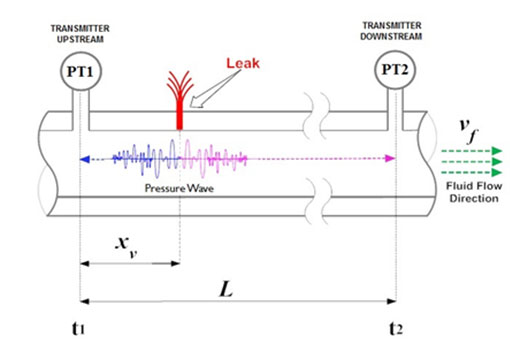It is widely known that the acoustic (negative-pressure wave) method is one of the most powerful methods for detecting pipeline leaks due to the real-time processing of dynamic events in the pipeline, fast response time (typically within a few minutes), and ability to locate the leak position along the pipeline with impressive precision.
The operating principle for an acoustic leak detection system is elegant and powerful. When a leak occurs, a drop in pressure will happen at the location of the leak. This causes pressure oscillations in the fluid which propagate as negative-pressure wave signals (also known as acoustic waves) at the speed of sound, through the fluid and away from the leak location in opposite directions.
By placing sensitive pressure transmitters (PTs) with fast response time (1 msec or better) along the pipeline and sampling the pressure in the pipeline using fast special-purpose Field Signal Processor (FSP) units, an acoustic leak detection system will detect the pressure transient wave associated with the pressure wave caused by the pipeline leak. In the literature, the traveling wave is often referred to as a “negative-pressure” wave, or the “expansion” wave[1]. The figure below shows the basic concept of an acoustic leak detection system.
Figure 2: Basic Concept in an Acoustic Leak Detection System
As shown, when a leak occurs, the sudden drop in pressure at the leak location causes oscillations in the fluid pressure that propagate in both directions, upstream and downstream, guided by the pipeline wall. Pressure transmitters (designated as PT1 and PT2) installed at opposite ends of the pipeline protected segment will detect the drop in pressure and transmit the oscillating pressure signals to their corresponding Field Signal Processors (FSP) unit.
The FSP unit is an integrated field-grade system which includes modules for data acquisition, signal conditioning, noise filtering, data processing and communication. The FSP unit first applies conditioning and filtering functions to separate leak signals from the background noise, and then applies advanced detection algorithms to determine if a leak “event” took place. The FSP units take into account fluid velocity (Vf), viscosity, pressure, and other pipeline specific parameters. Moreover, all leak events detected locally by the FSP units are time stamped using the GPS system.
The local FSP units at both ends of a pipeline segment then transmit the leak event(s) to the Central Controller (CC) unit with the time stamp, which analyses events coming from the FSP units. By performing real-time computation and applying a variety of advanced algorithms, the CC unit declares if a leak has occurred or not, and it will then compute its location.
The location of the leak is computed based on the negative pressure wave propagation velocity in the fluid, by examining the difference between wave arrival times (t1 – t2) at the two opposing Transmitters (PT1 and PT2), and the length of the pipeline segment, as shown in the equation below.
Where,
Xv = Distance from segment end to leak location
Lpipe = Length of this pipe segment
v = Negative-pressure wave propagation velocity in the fluid
t1 = Detection time at pressure transmitter PT1
t2 = Detection time at pressure transmitter PT2
It should be noted that not every pressure-based leak detection system is an acoustic system. In fact, many of the pressure transmitters (and associated computing equipment) that are commonly used in pressure-based leak detection systems do not qualify as acoustic transmitters/equipment due to their slow sampling rate and/or response time.
At PipeTech we use the fastest and most rigid available pressure transmitters in the industry to capture the negative-pressure wave traveling at the speed of sound and to meet the harshest industrial requirements for the oil and gas industry.


